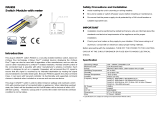instant power consumption to Group1 node every 1 hour. The maximum inter-
val to report its instant power consumption is 45 hours
(5s*32767/3600=45hr). When the setting is 0, PAN38 will disable Watt auto
report function. The default value is 720.
3-2 KWH Meter Report Period:
If the setting is configured for 1hour (set value =6), PAN38 will report its Ac-
cumulated Power Consumption (KWh) to Group1 node every 1 hour. The
maximum interval to report its Accumulated Power Consumption (KWh) is
227.55 days (10min*32767/1440=227.55 days). When the setting is 0, PAN38
will disable KWH auto report function. The default value is 6.
3-3 Threshold of current for Load Caution
This is a warning when the current of load over the preset threshold value, if
the setting value is 1300, when the load current of Relay1 over this value,
PAN38 will send current meter report to warn the Group1 node, the range of
the setting value is from 10 to 1300, and the default value is 1300.
3-4 Threshold of KWh for Load Caution
This is a warning when the KWh of load over the preset threshold value, If the
setting value is 10000, when the Accumulated Power Consumption of Relay1
over this value, PAN38 will send KWH meter report to warn the Group1
node, minimum value is 1KWh and default value is 10000 kWh.
3-5 Restore switch state mode:
Whenever the AC power return from lost, PAN38 will restore the switch state
which could be SWITCH OFF、LAST SWITCH STATE、SWITCH ON. The
default setting is LAST SWITCH STATE.
3-6 Mode of switch off function:
When the mode of switch On/Off is set to 0, any command of switch off will be
disabled and the On/Off function of include button will be disabled. The default
setting is enable mode. When manual On/Off function is disabled, the RF com-
mand can only switch On but not Off. This is useful function for keeping the de-
vice in switch on state.
3-7 LED indication mode: The default setting is Show Switch State.
3-7-1 Show Switch State:When switch is on, LED is on. When switch is off,
LED is off.
3-7-2 Show Night mode:When switch is on, LED is off. When switch is off,
LED is on.
3-7-3 One Flash mode :When the state of switch changes, LED will be on
only one second, then LED keeps off.
3-8 Watt differential mode:The default setting is 1 (= 5%).
Whenever Watt value of PAN38 changes over 5% of last reading value, it will
send Meter report to the group 1 nodes. However, if Watt differential mode as
0, the unsolicited report will be disabled.
3-9 Switch status report mode: The default setting is 1(Enable)
Whenever PAN38 manually switch on or off, it will send BINARY_SWITCH_
REPORT to the node of group1, disable when this config set to 0.
4. Firmware update over the air (OTA)
PAN38 is based on 700 series SoC and supports Firmware Update Command
Class, it can receive the updated firmware image sent by controller via the Z-
wave RF media. It is a helpful and convenient way to improve some function if
needed.
5. The Switch supports Command Classes including…
Command Class Version Required Security Class
Z-Wave Plus Info 2 None
Security 0 1 None
Security 2 1 None
Supervision 1 None
Transport Service 2 None






















